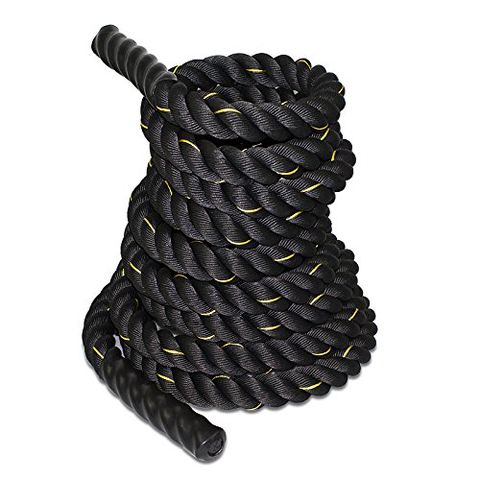
Most of the tried and true equipment you use at the gym is made of iron—but if you want a more dynamic, fat busting full-body workout, ditch the weights and pick up some ropes.
Ropes aren’t just for sailing and and Boy Scouts. Battle ropes (or battling ropes) are a must-have tool for anyone looking to pack on lean mass. “The key to their effectiveness is that they work each arm independently, eliminating strength imbalances as they sculpt your muscle,” John Brookfield, creator of the original battling-ropes system, told Men’s Health.
You’ll definitely work both arms, along with your back, chest, legs, and core, depending on your routine.
Adding ropes to your routine also provides a killer cardio workout without the monotony that comes with other aerobically-focused activities. You’ll sweat bullets while you swing, no matter what you’re training to do. You can train for power by slamming the ropes on the ground, too—the possibilities are endless.
Read on to maximize your burn—and brawn.
Battle Fat at Home
Training ropes come in various lengths and thicknesses, so you should know what you’re dealing with before you give any a swing. If you’re looking to buy some for your home setup, check these options out.
30 ft. 1.5 in.

Amazon
Buy Now
40 ft. 1.5 in.

Onnit
Buy Now
50 ft. 1.5 in.

Power Guidance
Buy Now.

ZENY
Buy Now
Or if you’re handy, just DIY your workout. You can buy 50 feet of generic 1 1/2-inch rope and wrap the ends in electrical tape.

Home Depot
Buy Now
To anchor your rope, just loop it around a pole or pick up one of these anchor strap kits to set it up in the weight room.

Eclipse Fitness
Buy Now
Training Rules to Swing By
Battling ropes are useful tools, but you won’t get anywhere if you just flail away aimlessly. If you’re going to pick up a rope, live by these rules to make the most of your workout.
TRAINING RULE 1: Move in Many Directions
Don’t just wave the ropes up and down. “Try different motions to work different muscles and skills,” said Brookfield. Going from side to side, for example, places more emphasis on your hips and core, building total-body stability. Moving the ropes in circles improves shoulder mobility and range of motion, boosting athleticism and reducing your risk of injury. Switching among different motions in your training sessions will help you sculpt functional real-world strength.
TRAINING RULE 2: Use Ropes for Everything
Lots of guys use battling ropes as a finisher or as one exercise in a larger circuit. “But ropes also make for a great workout in and of themselves,” Brookfield advised. You might do each exercise for 10 minutes, for example, or do waves alone for a full 20 minutes. “Doing one task for extended periods teaches your mind to focus and helps your body flush lactic acid.” It also extends the time your muscles are under tension, helping you build strength as you shed fat.
TRAINING RULE 3: Adjust the Resistance
The amount of slack in the rope determines the load. “Moving away from the anchor point decreases exercise intensity, while stepping toward the anchor point increases it,” Brookfield said. Adjust the slack so you’re challenged to complete each set. If you’re doing a battling-rope workout, alternate between two minutes closer to the anchor point and one minute farther away. “The time you spend farther from the anchor is active recovery.”
Two Rope Exercises You Must Master
1. Battling-Rope Waves
This is the classic battling-rope exercise. “It works each arm independently and keeps your muscles under tension for extended periods,” said Brookfield.

Directions: Hold the ends of the rope at arm’s length in front of your hips with your hands shoulder-width apart. Brace your core and begin alternately raising and lowering each arm explosively. Keep alternating arms for three to four sets of 1 to 2 minutes.
2. Battling-Rope Crossovers
Instead of making waves, slam the rope to the ground. “You’ll build more power and hammer your core,” says Brookfield.

Directions: Keep both feet flat on the floor as you move the ends in an arc above your head, lifting them to your left and slamming them down hard to your right. Repeat in the opposite direction. Continue alternating for three to four sets of 1 to 2 minutes.
Perfect those two basic moves to start, then give these other variations a try.
Source: Read Full Article
